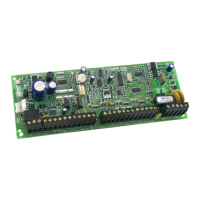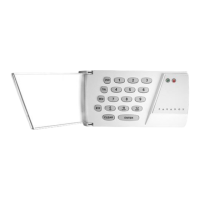Notes re:
728
The designation for zones 1, 2, 3, 4, 5 and 6 can be changed to zones 7, 8, 9, 10, 11 and 12
respec
tively so that they form part of system “B”.
Zones 1 and 2 will be swapped with zones 7 and 8.
Zones that are not selected (light "on") are common to both systems and will be armed only if the panel is
fully armed.
Note: When partitioning is not activated (address 206, key [8] "off") any zones selected at addresses 240
and 242 will be armed upon "stay" arming. See also "Partitioning" pages 15-16.
Keypad display:
Both systems are displayed on the keypad at the same time. In partitioning mode, when System "A" is
armed, the [STAY] key flashes. If System "B" is armed, the [AWAY] key flashes.
If both systems are armed, both of these keys will flash.
Silent alarm (Address 206, key [9])
Key [9] "off":
Zones defined as "silent" at address 216 and keypad panic zones will not cause an audible alarm,
however, the keypad "armed" light will flash and the alarm condition will remain until a valid user
code is entered.
Key [9] "on":
Silent zones/panics generate only a report (no flashing red LED on keypad, no need to "reset" the
silent alarm).
Silent delay zones generate an entry delay beep, and a report at the end of the entry delay.
Zone restore is always reported on zone close.
Memory display and auto zone shut-down (when enabled at address 206, key [TRBL]) are always
active for silent zones.
Silent alarms can be monitored by a PGM output. (Silent flag is cleared on reporting or disarm.)
On split reporting, silent zones/panic are reported to Telephone #1.
The Contact ID report for all zones is "burglary".
Dialing pulse rates (for Espload) (Address 206, key [10])
This selection reflects the ratio between pulse time and "quiet" time. Select Pulse Europe for a 1:2 ratio,
Pulse USA for 1:1.5. (Key [10] = "on")
Reporting options
Regular reporting
(Address 206, key [11] and key [12])
To activate central station reporting, the feature must be enabled and all required reporting codes must
be assigned a value other than [2ND][2ND].
To establish communication, the communicator takes the telephone line and waits for a dial tone. If a dial
tone is identified, the communicator will dial the second central station telephone number. If a connection
is made, system report will take place and the communicator will hang-up upon completion. If for any rea-
son, communication is interrupted, the communicator will redial the central and report only the events that
were not reported during the interrupted attempt.
During a communication attempt, the communicator waits for a dial tone for up to 8 seconds (versions
0.97B, 1.04 and 1.4 onward). (In previous versions, the communicator waits up to 16 seconds for a dial
tone.) Even if a dial tone is not found, the communicator will dial the central station.* (See * page 28)
After 60 seconds, if communication has not been established, the dialer will hang up, wait 5 seconds and
try the first number. This sequence will be repeated 8 times, switching back and forth between the 1
st
and
2
nd
number. (Regular reporting dialing procedure: 2,1,2,1,2,1,2,1, "communicator report failure").
27
IM8

